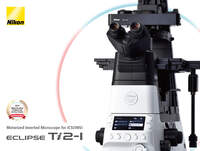- it Change Region
- Global Site
- Casa
- Prodotti
- Microscopi invertiti
- ECLIPSE Ti2-I
ECLIPSE Ti2-I
Motorized inverted microscope for ICSI and IMSI
Customer Interviews
Intervista al cliente “Automated settings enhance the efficiency of ART in clinical practice, research, and development.”
The ECLIPSE Ti2-I: Contributing to assisted reproductive technology (ART)
The declining birth rate presents a critical social issue that demands attention. Advancements in assisted reproductive technology (ART) are further anticipated to play a key role in addressing this issue. Fujita Medical Innovation Center Tokyo (FMiC) is committed to clinical practice, and the ongoing research and development of ART to help more people wishing to become parents. Nikon’s motorized inverted microscope for ICSI/IMSI, the ECLIPSE Ti2-I, plays a key role in this process. To gain deeper insights into its implementations and practical applications, we spoke with Dr. Tatsuya Kobayashi, an embryologist and Associate Professor at Fujita Health University’s Department of Regulatory Science.
*This page contains interviews with healthcare professionals regarding our products. However, these interviews do not guarantee the efficacy, effectiveness, or performance of the products, nor do they constitute an official endorsement, recommendation, advice, or selection by the featured professionals.
The ECLIPSE Ti2-I: Advancing and expanding ART
The Fujita Medical Innovation Center Tokyo, located at Haneda Innovation Center
The ECLIPSE Ti2-I in use at the advanced medical research center
Fujita Health University
Fujita Medical Innovation Center Tokyo
The Center for Advanced Reproductive Medicine
Department of Regulatory Science
Associate Professor
Tatsuya Kobayashi, Ph.D.
*Position and affiliation are as of the time of the interview.
ART encompasses infertility treatments such as in vitro fertilization (IVF). Alongside research in regenerative medicine and cancer genomics, FMiC is actively advancing ART through clinical practice, research, and the training of future medical professionals. Established in 2023 at Haneda Innovation City near Haneda International Airport by Fujita Health University, the center serves as a hub to address the evolving needs of next-generation healthcare. “I work as an embroyologist at the Fujita Health University Haneda Clinic, which is part of the center. Embryologists are responsible for procedures such as in vitro fertilization (IVF) and embryo cultivation under the supervision of physicians,” explains Associate Professor Dr. Tatsuya Kobayashi from the Department of Regulatory Science at Fujita Health University.
The FMiC and Haneda Clinic utilize a range of advanced tools and technologies to support the work of embryologists and physicians in both research and clinical applications of ART. Among these, Nikon microscopes play a vital role in their efforts. In particular, the ECLIPSE Ti2-I motorized inverted microscope for ICSI/IMSI* supports both clinical practice and the exploration of new possibilities in ART.
*ICSI is a technique where sperm is directly injected into the egg under a microscope, and IMSI is a method used to select sperm for ICSI.
The ECLIPSE Ti2-I: Improving the accuracy and efficiency of ICSI
Microscopes are crucial for ICSI, and Nikon’s ECLIPSE Ti2-I motorized inverted microscope is specifically designed for ART. It supports both ICSI and its preparatory stage through enabling precise selection of morphologically normal sperm (IMSI) by means of its high-magnification lens. Its advanced features allow complex settings to be made easily using buttons and touchscreen monitors. By automating key settings, it helps reduce the workload of embryologists and physicians while enhancing the accuracy of ICSI procedures.
Switch settings with the push of a button
The ECLIPSE Ti2-I equipped with a third-party manipulator
Settings can also be adjusted via the touchscreen
Microscopes are essential tools during the many steps of ART. At FMiC, Nikon’s stereo microscope, the SMZ18, is used to locate eggs within follicular fluid retrieved from the ovaries. Sperm samples are analyzed for motility and condition using Nikon’s upright microscope, the ECLIPSE Ci. The center also utilizes an automated sperm analysis system that incorporates the ECLIPSE Si upright microscope.
We spoke with Dr. Kobayashi about the introduction of the ECLIPSE Ti2-I, his experience with its operation, and its potential benefits.
Simplifying the procedures for ICSI
The ECLIPSE Ti2-I motorized inverted microscope for ICSI/IMSI
― What is the background to the introduction of the ECLIPSE Ti2-I?
Dr. Kobayashi: “The number of ART procedures is growing worldwide, but the shortage of embryologists remains a significant challenge. As a potential solution, we introduced the ECLIPSE Ti2-I to explore ways of improving the workflow efficiency for embryologists. Our study aimed to evaluate how emerging technologies, such as automation and AI-driven analysis systems, could help reduce their workload. In particular, we examined whether the partial motorization of the microscope could shorten the time required for ICSI procedures.”
― What was the study’s approach and what did the results show?
Dr. Kobayashi: “We compared the time required for ICSI using both the ECLIPSE Ti2-I, which features automated settings, and a conventional microscope that requires manual adjustments. The results revealed a significant reduction in ICSI procedure time with the ECLIPSE Ti2-I and suggested that workload may vary depending on the type of microscope used. While this study was conducted with a small group, we plan to expand the participant pool and continue our research.”
An example of ICSI performed with the ECLIPSE Ti2-I
― What are your thoughts on using the ECLIPSE Ti2-I?
Dr. Kobayashi: “I find it very easy to use. For example, during ICSI procedures, different steps require adjustments to various components, such as the objective lens and filters, which can add complexity and increase the workload for embryologists. However, with the ECLIPSE Ti2-I, a single press of a button automatically adjusts the settings for each step, allowing embryologists to focus entirely on the eggs and sperms. We currently perform ICSI with both the ECLIPSE Ti2-I and a conventional microscope, but whenever possible, I prefer using the ECLIPSE Ti2-I.”
― What are the prospects for the ECLIPSE Ti2-I?
Dr. Kobayashi: “ICSI procedures have traditionally required a high level of expertise, but simplifying the workflow can help ensure more consistent ART delivery. Working with the earliest stages of life, embryologists take on great responsibilities handling the delicate procedures. Reducing their workload can help alleviate stress and lower the risk of medical errors. The microscope’s intuitive controls also make it easier to develop materials to support the education of future embryologists.”
Advancing ART: Innovation, and training new generations
Taking initiatives on developing new technology
Dr. Kobayashi also shared with us his future initiatives. “In addition to the ongoing research and development at the center, we are collaborating with other organizations and companies to address the shortage of embryologists. As part of this effort, we are using Nikon’s ECLIPSE Ti2-U as a base to develop a microscope and micromanipulator* that can be remotely operated, aiming to make ART accessible even in regions with less experienced embryologists.” He further shared, “We are also working on developing an educational manipulator* to support embryologist training. As mastering ART techniques requires significant time, our goal is to help trainees acquire these skills more efficiently and accurately.”
Lastly, we asked Dr. Kobayashi about his roles as a university professor and in the training of embryologists. “While ART continues to evolve with new discoveries and techniques, some areas still lack strong medical evidence. My goal is for Fujita Health University to become a place where embryologists can come together to learn, research, and establish a solid foundation of evidence — contributing to sharing Japan’s ART advancements with the world. I will also continue to support such growth and development in the hope that embryologists will gain greater recognition and play an even more prominent role in society.” Nikon is also committed to continuously refining microscopy technology and contributing to this vital field, supporting Dr. Kobayashi’s dedication to helping bring new life to brighten the future.
*The controller for remote operation and micromanipulators are not supplied as Nikon microscope attachments. They are still in development and are not Nikon products.
Note: The products mentioned in this article reflect their usage in Japan at the time of the interview.
- Casa
- Prodotti
- Microscopi invertiti
- ECLIPSE Ti2-I

